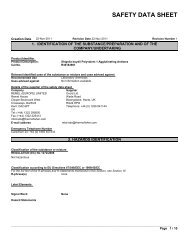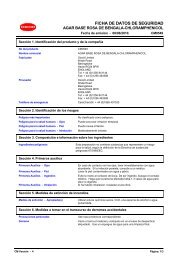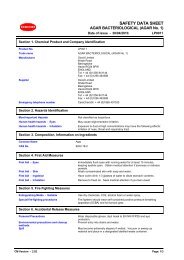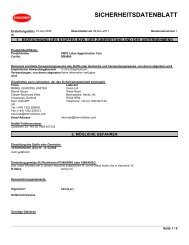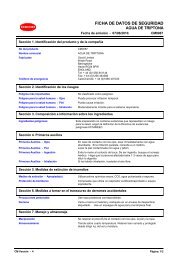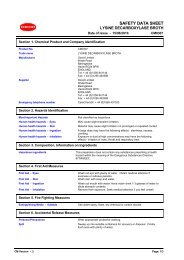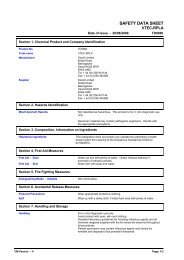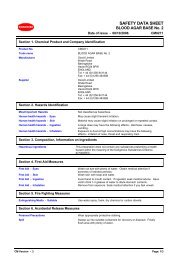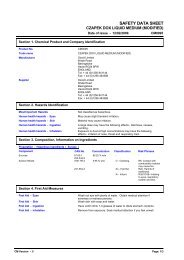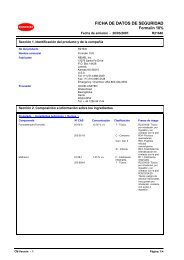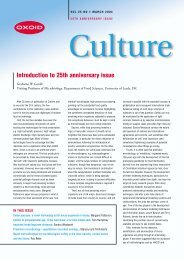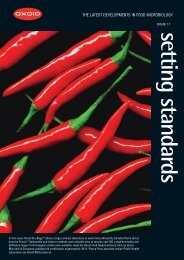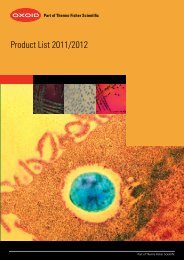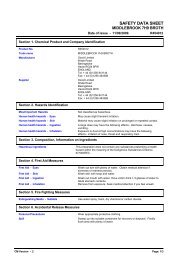IMAGEN™ Adenovirus - Oxoid
IMAGEN™ Adenovirus - Oxoid
IMAGEN™ Adenovirus - Oxoid
You also want an ePaper? Increase the reach of your titles
YUMPU automatically turns print PDFs into web optimized ePapers that Google loves.
14.3 CLINICAL PERFORMANCE<br />
14.3.1 Direct Specimens<br />
Nasopharyngeal Secretions<br />
Fresh clinical specimens were tested during the winter of 1988/89 and stored (frozen) specimens which had<br />
been collected between 1978 and 1988 were also tested. The two centres compared IMAGEN<br />
<strong>Adenovirus</strong> test with reference methods. A result by the reference method was considered positive if either<br />
the cell culture or indirect immunofluorescence was positive. This allowed for the presence of non-viable<br />
virus to be detected by fluorescence or cell-free virus to be detected by cell culture. A specimen was scored<br />
positive in the IMAGEN <strong>Adenovirus</strong> test when one or more fluorescing epithelial cells were seen (see<br />
Section 11.2).<br />
Table 14.1 shows the results of the IMAGEN <strong>Adenovirus</strong> test reagent. The overall incidence of<br />
adenovirus in these populations was 9.1% (43/474). The results correlated with the standard tests in 468<br />
cases (98.7%). The IMAGEN <strong>Adenovirus</strong> test sensitivity was 86.0% (37/43) and specificity was 100%<br />
(431/431). The predictive values for positive and negative results were 100% (37/37) and 98.6% (431/437)<br />
respectively.<br />
Table 14.1 Comparison of test results by the IMAGEN <strong>Adenovirus</strong> test and cell culture on<br />
nasopharyngeal specimens at 2 trial centres<br />
TEST RESULT<br />
Reference method<br />
IMAGEN <strong>Adenovirus</strong><br />
Neg<br />
Neg<br />
No. of Specimens (474) 431 37 6* 0<br />
*1) 4/6 specimens took greater than 10 days to produce CPE in culture. This may indicate a very low<br />
level of virus initially present in the sample.<br />
2) 2/6 specimens were negative by indirect IF.<br />
Ophthalmic Specimens<br />
The IMAGEN <strong>Adenovirus</strong> test was evaluated against an established cell culture system. Conjunctival<br />
swabs were collected from 179 patients with conjunctivitis attending an eye hospital. The incidence of<br />
adenovirus infection in the population group studied was 19.6% (35/179). Smears were prepared from<br />
specimen swabs at the clinic and the swabs were then placed in a transport medium for cell culture<br />
evaluation. A specimen was scored positive in the IMAGEN <strong>Adenovirus</strong> test when one or more<br />
fluorescing epithelial cells were observed (see Section 11.2). A specimen was scored positive in the cell<br />
culture test when characteristic cytopathic effect was confirmed by indirect immunofluorescence. The<br />
results from this trial are shown in Table 14.2. Of 179 specimens tested, the same result was obtained by<br />
both methods in 174 specimens after repeat testing, giving a correlation of 97.2%. The sensitivity and<br />
specificity of the IMAGEN <strong>Adenovirus</strong> test was 91.4% (32/35) and 98.6% (142/144) respectively. The<br />
predictive values for positive and negative tests were 94.1% (32/34) and 97.9% (142/145) respectively.<br />
Table 14.2 Comparison of test results by the IMAGEN <strong>Adenovirus</strong> test and cell culture on<br />
human ophthalmic specimens<br />
TEST RESULT<br />
Reference method<br />
IMAGEN <strong>Adenovirus</strong><br />
Neg<br />
Neg<br />
No. of Specimens (179) 142 32 3* 2**<br />
* Insufficient material available for retesting of one specimen.<br />
** Both specimens were cultured for only 2 days.<br />
Pos<br />
Pos<br />
Pos<br />
Pos<br />
Pos<br />
Neg<br />
Pos<br />
Neg<br />
Neg<br />
Pos<br />
Neg<br />
Pos<br />
10/37 K6100EFG



